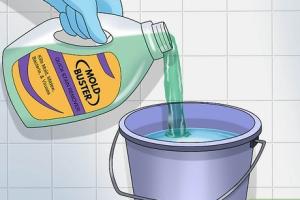Ultimate Guide: How to Effectively Clean Mold Off Concrete Surfaces

-
Quick Links:
- Introduction
- Understanding Mold
- Why Cleaning Mold is Important
- Tools and Materials Needed
- Step-by-Step Guide to Clean Mold Off Concrete
- Preventing Future Mold Growth
- Case Studies
- Expert Insights
- FAQs
Introduction
Mold growth on concrete surfaces can be an unsightly and potentially harmful issue for homeowners and property managers alike. Whether it appears on driveways, patios, or basement floors, understanding how to effectively clean mold off concrete is essential for maintaining both the aesthetics and safety of your living environment. In this comprehensive guide, we will walk you through the process of mold removal, provide insights into prevention, and share expert tips to ensure your concrete surfaces remain clean and mold-free.
Understanding Mold
Mold is a type of fungus that thrives in damp, warm environments. It reproduces through tiny spores that can easily become airborne. While mold can appear in various colors, including black, green, and white, it is often the black mold that homeowners worry about due to its association with health risks.
Types of Mold Commonly Found on Concrete
- Aspergillus: Often appears as a green or black mold.
- Cladosporium: Can be black or green and thrives in damp areas.
- Stachybotrys: Known as black mold, it is particularly dangerous to health.
Why Cleaning Mold is Important
Cleaning mold off concrete is not just about aesthetics; it also involves health concerns. Mold can trigger allergic reactions, respiratory issues, and other health problems, particularly in vulnerable individuals such as children and the elderly. Additionally, mold can damage concrete surfaces over time, leading to costly repairs.
Tools and Materials Needed
Before beginning the mold removal process, gather the following tools and materials:
- Safety goggles and gloves
- Face mask or respirator
- Stiff-bristle brush or broom
- Pressure washer (optional)
- Commercial mold cleaner or DIY solution
- Bucket
- Sponge or cloth
- Water source
Step-by-Step Guide to Clean Mold Off Concrete
Step 1: Prepare the Area
Clear the area of any furniture, plants, or obstacles. Ensure proper ventilation if you are working indoors.
Step 2: Wear Protective Gear
Put on safety goggles, gloves, and a face mask to protect yourself from mold spores and cleaning solutions.
Step 3: Choose Your Cleaning Solution
You can use a commercial mold cleaner or create a DIY solution using equal parts of water and white vinegar or bleach. Note that bleach may be less effective on porous surfaces.
Step 4: Apply the Cleaning Solution
Using a spray bottle, apply the cleaning solution directly onto the mold-affected areas. Allow it to sit for at least 10-15 minutes to penetrate the mold.
Step 5: Scrub the Area
Using a stiff-bristle brush, scrub the mold off the concrete. For large areas, a pressure washer can be used to remove the mold more effectively.
Step 6: Rinse the Surface
Thoroughly rinse the area with clean water to remove any remaining cleaning solution and mold residue.
Step 7: Dry the Surface
Allow the concrete to dry completely. This is crucial as moisture can lead to mold regrowth.
Preventing Future Mold Growth
After cleaning, it’s important to take steps to prevent mold from returning:
- Ensure proper drainage around your property.
- Seal any cracks or holes in the concrete.
- Keep the area well-ventilated.
- Consider using a mold-resistant sealant on your concrete surfaces.
- Regularly inspect and clean outdoor areas, especially after heavy rain.
Case Studies
Case Study 1: Residential Patio
A homeowner in Florida noticed black mold on their concrete patio after a series of rainstorms. After following the cleaning steps outlined above, they reported a significant improvement and took the preventative measures to seal the patio, which reduced future mold growth.
Case Study 2: Commercial Warehouse
A warehouse manager faced recurring mold issues on their concrete floors. By implementing a regular cleaning schedule and improving ventilation, they successfully reduced mold incidents by 75% over six months.
Expert Insights
According to Dr. Jane Doe, a mold remediation expert, "Proper cleaning and maintenance of concrete surfaces not only enhance appearance but also reduce health risks. Always prioritize safety when dealing with mold."
FAQs
1. What is the best way to clean mold off concrete?
The best way is to use a mix of water and vinegar or a commercial mold cleaner, scrub thoroughly, and rinse well.
2. Can I use bleach to clean mold off concrete?
Yes, but bleach may not penetrate porous surfaces effectively. Vinegar is a safer alternative for most applications.
3. How do I know if the mold is toxic?
Black mold (Stachybotrys) is commonly regarded as toxic. If you suspect toxic mold, it’s best to consult a professional.
4. Is it safe to clean mold indoors?
Yes, but ensure proper ventilation and wear protective gear to minimize inhalation of spores.
5. How can I prevent mold from returning?
Maintain proper drainage, seal concrete surfaces, and keep areas dry and well-ventilated.
6. How often should I clean mold off concrete?
It depends on your environment, but a biannual cleaning is a good practice to prevent mold growth.
7. What should I do if the mold returns?
If mold returns, reassess your cleaning methods and consider professional remediation if necessary.
8. Can I pressure wash mold off concrete?
Yes, pressure washing is an effective way to remove mold from large concrete areas.
9. What are the health risks of mold exposure?
Mold exposure can lead to respiratory issues, allergies, and other health problems, especially in sensitive individuals.
10. Is there a way to naturally prevent mold?
Yes, using essential oils like tea tree oil or maintaining low humidity levels can help prevent mold growth.